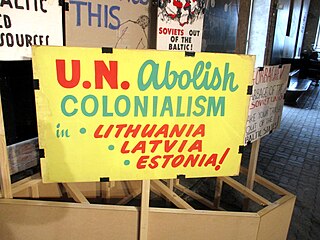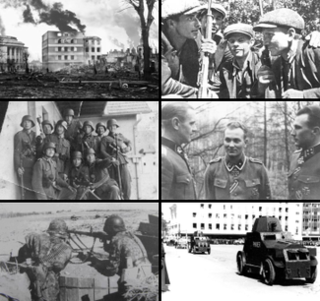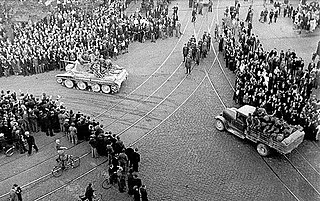| |||||
| Decades: | |||||
|---|---|---|---|---|---|
| See also: | |||||
This article lists events that occurred during 1991 in Estonia .
| |||||
| Decades: | |||||
|---|---|---|---|---|---|
| See also: | |||||
This article lists events that occurred during 1991 in Estonia .
| | This section is empty. You can help by adding to it. (December 2020) |
| | This section is empty. You can help by adding to it. (December 2020) |

The Republics of the Union of Soviet Socialist Republics or the Union Republics were national-based administrative units of the Union of Soviet Socialist Republics (USSR). The Soviet Union was formed in 1922 by a treaty between the Soviet republics of Byelorussia, Russian Federation, Transcaucasian Federation, and Ukraine, by which they became its constituent republics of the Union of Soviet Socialist Republics.

The Baltic states or the Baltic countries is a geopolitical term, which currently is used to group three countries: Estonia, Latvia, and Lithuania. All three countries are members of NATO, the European Union, the Eurozone, and the OECD. The three sovereign states on the eastern coast of the Baltic Sea are sometimes referred to as the "Baltic nations", less often and in historical circumstances also as the "Baltic republics", the "Baltic lands", or simply the Baltics.

The Singing Revolution was a series of events in 1987–1991 that led to the restoration of independence of the three then Soviet-occupied Baltic countries of Estonia, Latvia, and Lithuania at the end of the Cold War. The term was coined by an Estonian activist and artist, Heinz Valk, in an article published a week after the 10–11 June 1988 spontaneous mass evening singing demonstrations at the Tallinn Song Festival Grounds.

The Latvian Soviet Socialist Republic, also known as Soviet Latvia or simply Latvia, was a republic in the Soviet Union. The Latvian SSR existed for over 50 years, from 5 August 1940 to 6 September 1991.

The three independent Baltic countries – Estonia, Latvia, and Lithuania – were invaded and occupied in June 1940 by the Soviet Union, under the leadership of Stalin and auspices of the Molotov–Ribbentrop Pact that had been signed between Nazi Germany and the Soviet Union in August 1939, immediately before the outbreak of World War II. The three countries were then annexed into the Soviet Union in August 1940. The United States and most other Western countries never recognised this incorporation, considering it illegal. On 22 June 1941, Nazi Germany attacked the Soviet Union and within weeks occupied the Baltic territories. In July 1941, the Third Reich incorporated the Baltic territory into its Reichskommissariat Ostland. As a result of the Red Army's Baltic Offensive of 1944, the Soviet Union recaptured most of the Baltic states and trapped the remaining German forces in the Courland Pocket until their formal surrender in May 1945.

The Act of the Re-Establishment of the State of Lithuania or Act of March 11 was an independence declaration by Lithuania adopted on March 11, 1990, signed by all members of the Supreme Council of the Republic of Lithuania led by Sąjūdis. The act emphasized restoration and legal continuity of the interwar-period Lithuania, which was occupied by the Soviet Union and annexed in June 1940. In March, 1990, it was the first of the 15 Soviet republics to declare independence, with the rest following suit over the ensuing twenty-one months. These events led to the dissolution of the Soviet Union in December 1991.

Estonia declared neutrality at the outbreak of World War II (1939–1945), but the country was repeatedly contested, invaded and occupied, first by the Stalinist Soviet Union in 1940, then by Nazi Germany in 1941, and ultimately reinvaded and reoccupied in 1944 by the Soviet Union.

The three Baltic countries, or the Baltic states – Estonia, Latvia, and Lithuania – are held to have continued as legal entities under international law while under the Soviet occupation from 1940 to 1991, as well as during the German occupation in 1941–1944/1945. The prevailing opinion accepts the Baltic thesis of illegal occupation and the actions of the USSR are regarded as contrary to international law in general and to the bilateral treaties between the USSR and the three Baltic countries in particular.

The Soviet occupation of Latvia in 1940 refers to the military occupation of the Republic of Latvia by the Soviet Union under the provisions of the 1939 Molotov–Ribbentrop Pact with Nazi Germany and its Secret Additional Protocol signed in August 1939. The occupation took place according to the European Court of Human Rights, the Government of Latvia, the United States Department of State, and the European Union. In 1989, the USSR also condemned the 1939 secret protocol between Nazi Germany and herself that had led to the invasion and occupation of the three Baltic countries, including Latvia.

The Declaration "On the Restoration of Independence of the Republic of Latvia" was adopted on 4 May 1990 by the Supreme Soviet of the Latvian SSR in which Latvia declared independence from the Soviet Union. The Declaration stated that, although Latvia had de facto lost its independence in 1940, when it was annexed by the Soviet Union, the country had de jure remained a sovereign country as the annexation had been unconstitutional and against the will of the Latvian people. It asserted the priority of the basics of the international law over the national laws and therefore it resolved that the Molotov–Ribbentrop Pact and the Soviet occupation of Latvia in 1940 were illegal. It also asserted that the heavily rigged 1940 elections were illegal and unconstitutional, and that all acts of the People's Saeima chosen at that election–including the request to join the Soviet Union on 21 July 1940–were ipso facto void.
The Estonian Sovereignty Declaration, fully: Declaration on the Sovereignty of the Estonian SSR, was issued on November 16, 1988 during the Singing Revolution in the Estonian SSR. The declaration asserted Estonia's sovereignty and the supremacy of the Estonian laws over the laws of the Soviet Union. Estonia's parliament also laid claim to the republic's natural resources: land, inland waters, forests, mineral deposits and to the means of industrial production, agriculture, construction, state banks, transportation, municipal services, etc. in the territory of Estonia's borders. November 16 is now celebrated annually as the "Day of Declaration of Sovereignty".

Relevant events began regarding the Baltic states and the Soviet Union when, following Bolshevist Russia's conflict with the Baltic states—Lithuania, Latvia and Estonia—several peace treaties were signed with Russia and its successor, the Soviet Union. In the late 1920s and early 1930s, the Soviet Union and all three Baltic States further signed non-aggression treaties. The Soviet Union also confirmed that it would adhere to the Kellogg–Briand Pact with regard to its neighbors, including Estonia and Latvia, and entered into a convention defining "aggression" that included all three Baltic countries.
The Sovietization of the Baltic states refers to the sovietization of all spheres of life in Estonia, Latvia and Lithuania when they were under control of the Soviet Union. The first period deals with the occupation from June 1940 to July 1941 when the German occupation began. The second period covers 1944 when the Soviet forces pushed the Germans out, until 1991 when independence was declared.

The three Baltic states – Estonia, Latvia and Lithuania – were re-occupied in 1944–1945 by the Soviet Union (USSR) following the German occupation. The Baltic states regained independence in 1990–1991.

The Soviet occupation of the Baltic states covers the period from the Soviet–Baltic mutual assistance pacts in 1939, to their invasion and annexation in 1940, to the mass deportations of 1941.

The Soviet Union (USSR) occupied most of the territory of the Baltic states in its 1944 Baltic Offensive during World War II. The Red Army regained control over the three Baltic capitals and encircled retreating Wehrmacht and Latvian forces in the Courland Pocket where they held out until the final German surrender at the end of the war.

An independence referendum was held in Lithuania on 9 February 1991, eleven months after independence from the Soviet Union had been declared on 11 March 1990. Just over 93% of those voting voted in favour of independence, while the number of eligible voters voting "yes" was 76.5%, far exceeding the threshold of 50%. Independence was subsequently achieved in August 1991. The independence of the Republic of Lithuania was re-recognized by the United States on 2 September 1991 and by the Soviet Union on 6 September 1991.

The dissolution of the Soviet Union was the process of internal disintegration within the Soviet Union (USSR), which resulted in the end of the existence of the country and of its federal government as a sovereign state, which in turn resulted in its 15 constituent republics gaining full independence on 26 December 1991. It brought an end to General Secretary Mikhail Gorbachev's effort to reform the Soviet political and economic system in an attempt to stop a period of political stalemate and economic backslide. The Soviet Union had experienced internal stagnation and ethnic separatism. Although highly centralized until its final years, the country was made up of 15 top-level republics that served as homelands for different ethnicities. By late 1991, amid a catastrophic political crisis, with several republics already departing the Union and the waning of centralized power, the leaders of three of its founding members declared that the Soviet Union no longer existed. Eight more republics joined their declaration shortly thereafter. Gorbachev resigned in December 1991 and what was left of the Soviet parliament voted to end itself.

Latvia–Taiwan relations, also retroactively known as ROC–Latvian relations date back to August 16, 1923, when the Republic of China recognized Latvia de jure, in that period when the island of Taiwan was under Japanese colonial rule. After the Soviet occupation of Latvia in 1940, the ROC is one of the few countries that did not recognize Latvia's incorporation into the Soviet Union.
This article lists events that occurred during 1989 in Estonia.